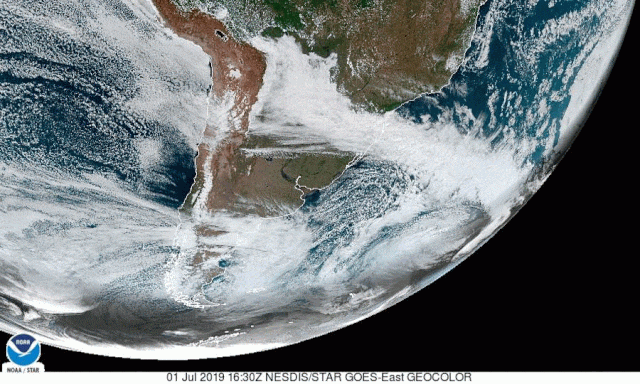Solar Eclipse Weather Update: Here's the Forecast for the Path of Totality
The skies over South America will be mostly cloud-free during the total solar eclipse today.

If you're planning on watching the total solar eclipse in South America today (July 2), the chances of clouds obstructing your view are slim. However, skywatchers viewing a partial eclipse outside the path of totality may not be so lucky.
While most of South America is will be able to witness at least a partial eclipse, in which the moon appears to take a "bite" out of the sun, only those who are positioned along a 125-mile-wide (200 kilometers) path across Chile and Argentina will get to experience a few moments of twilight as the moon completely blocks the sun from view.
If you're in the path of totality, which starts near La Serena, Chile and ends just south of Buenos Aires, Argentina, you're in luck — not only because you can see the rare celestial spectacle that is a total solar eclipse, but also because you'll likely have the clearest skies in all of South America.
Related: Total Solar Eclipse 2019: Path, Viewing Maps and Photo Guide
Although you might see a cloud or two along the path of totality, overall the weather forecast there looks like it will provide excellent conditions for viewing the eclipse.
In the rest of the South American continent, however, the chances of having your partial solar eclipse getting "eclipsed" by clouds is a bit higher.
Here's a look at the weather for tomorrow's total #EclipseSolar2019 eclipse across #Chile (excellent) and #Argentina (BA will likely see clouds). #worldsmostbeautifulweathermaps pic.twitter.com/bKWj6QGWHFJuly 2, 2019
According to Accuweather, the cloudiest places during the eclipse will be the southern tip of the continent and the northern countries of Colombia and Venezuela.
Breaking space news, the latest updates on rocket launches, skywatching events and more!
Anyone watching the eclipse in Colombia or Venezuela (where only the country's southernmost region can see the partial eclipse) would only be able to watch the moon cross over a tiny fraction of the sun anyway, because at maximum eclipse about 2% of the sun's surface will be covered.
Northern Brazil may also experience some eclipse-obstructing cloud coverage, as will a small region stretching from northern Argentina, through southern Paraguay and into São Paulo, Brazil.
Tuesday will bring the first #TotalSolarEclipse anywhere in the world since the 'Great American Eclipse' on Aug. 21, 2017. But this time, the path of totality will be in #Chile and #Argentina. The latest weather forecast: https://t.co/2r5BzP10eQ pic.twitter.com/RpedJBcVkPJuly 1, 2019
If you're worried that clouds may spoil your eclipse, it might not be too late to adjust your travel plans and drive toward a place where the sky will be clearer. But if that's not an option, you can also tune in to several live webcasts of the eclipse here.
And if a cloud does roll in during totality, blocking your view of the show, don't stop looking up! Instead, scope out the skies to see if you can spot planets, stars and constellations that are otherwise not visible from the Southern Hemisphere this time of year.
Happy skywatching, and may the weather gods be in your favor!
Editor's Note: If you snap an amazing picture of the July 2, 2019 total solar eclipse and would like to share it with Space.com's readers, send your photos, comments, and your name and location to spacephotos@space.com.
- Solar Eclipse 2019 in Chile: Chasing Totality in the Atacama Desert
- Amazing Solar Eclipse Pictures from Around the World
- Solar Eclipses: When Is the Next One?
Email Hanneke Weitering at hweitering@space.com or follow her @hannekescience. Follow us on Twitter @Spacedotcom and on Facebook.

Hanneke Weitering is a multimedia journalist in the Pacific Northwest reporting on the future of aviation at FutureFlight.aero and Aviation International News and was previously the Editor for Spaceflight and Astronomy news here at Space.com. As an editor with over 10 years of experience in science journalism she has previously written for Scholastic Classroom Magazines, MedPage Today and The Joint Institute for Computational Sciences at Oak Ridge National Laboratory. After studying physics at the University of Tennessee in her hometown of Knoxville, she earned her graduate degree in Science, Health and Environmental Reporting (SHERP) from New York University. Hanneke joined the Space.com team in 2016 as a staff writer and producer, covering topics including spaceflight and astronomy. She currently lives in Seattle, home of the Space Needle, with her cat and two snakes. In her spare time, Hanneke enjoys exploring the Rocky Mountains, basking in nature and looking for dark skies to gaze at the cosmos.
